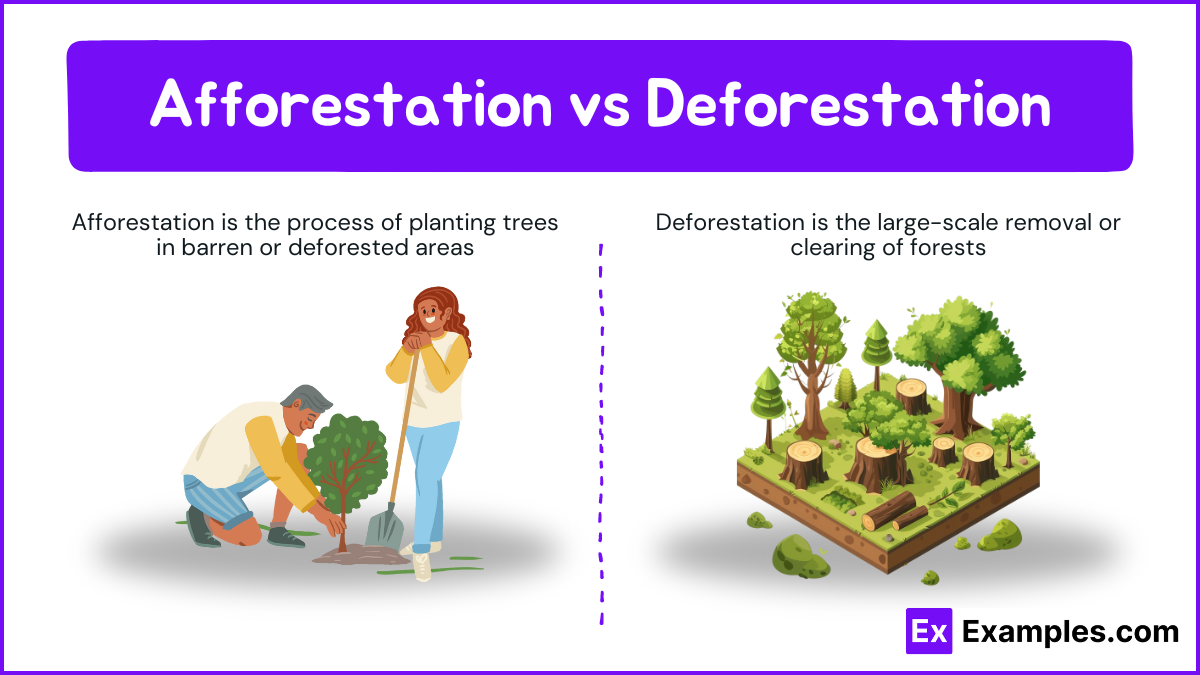What is the main goal of afforestation?
To clear land for agriculture
To plant trees in previously non-forested areas
To cut down old-growth forests
To prevent soil erosion by removing vegetation


Afforestation and deforestation are critical topics in environmental science and global sustainability. Afforestation involves planting trees in areas where there were none before, promoting biodiversity, combating climate change, and enhancing ecosystems. In contrast, deforestation refers to the large-scale removal of forests, leading to habitat loss, increased carbon emissions, and disrupted water cycles. Understanding the differences between afforestation and deforestation is essential for developing effective environmental policies and fostering a sustainable future. This article explores the impacts, benefits, and challenges associated with both processes, highlighting the urgent need for balanced and informed actions.
Afforestation is the process of planting trees in an area where there were no previous tree cover, transforming non-forested land into a forest. This is different from reforestation, which involves replanting trees in an area where a forest was cut down or destroyed.
Deforestation refers to the large-scale removal of forested areas, often resulting in significant environmental, social, and economic consequences. Here are some key points about deforestation:
| Aspect | Afforestation | Deforestation |
|---|---|---|
| Definition | Planting trees in an area where there were no previous tree cover | Clearing or removal of trees from an area |
| Purpose | Increase forest area, improve biodiversity, combat climate change | Harvest timber, clear land for agriculture or urban development |
| Environmental Impact | Positive: Increases carbon sequestration, improves air quality, supports wildlife habitats | Negative: Decreases biodiversity, contributes to climate change, disrupts ecosystems |
| Soil Impact | Improves soil quality, prevents erosion, enhances water retention | Leads to soil degradation, erosion, and loss of soil fertility |
| Water Cycle Impact | Enhances local water cycle, increases groundwater recharge | Disrupts water cycle, reduces rainfall, increases runoff and flood risk |
| Climate Impact | Mitigates climate change by absorbing CO2 | Exacerbates climate change by releasing stored carbon |
| Socio-economic Impact | Can provide economic benefits through sustainable forestry and tourism | Can provide short-term economic benefits but long-term environmental costs |
| Biodiversity | Increases biodiversity, creates new habitats | Reduces biodiversity, destroys habitats |
| Examples | Planting new forests in deserts or barren lands | Logging, agricultural expansion, urban sprawl |
Afforestation is the process of planting trees in areas where there were no previous forests, aiming to create new forested areas.
Deforestation is the removal or clearing of trees from forested areas, often to make way for agriculture, urban development, or logging.
Afforestation helps combat climate change, increases biodiversity, prevents soil erosion, and improves air and water quality.
Deforestation occurs primarily for agricultural expansion, urban development, and timber extraction.
Afforestation positively impacts the environment by sequestering carbon, enhancing biodiversity, and stabilizing soil.
Deforestation leads to habitat loss, decreased biodiversity, soil erosion, and increased greenhouse gas emissions.
Afforestation improves the water cycle by increasing groundwater recharge and reducing runoff.
Deforestation disrupts the water cycle, reducing rainfall and increasing flood risk.
Afforestation provides sustainable forestry, tourism opportunities, and long-term environmental benefits.
Deforestation offers short-term economic gains but results in long-term environmental degradation and loss of ecosystem services.
Text prompt
Add Tone
10 Examples of Public speaking
20 Examples of Gas lighting
What is the main goal of afforestation?
To clear land for agriculture
To plant trees in previously non-forested areas
To cut down old-growth forests
To prevent soil erosion by removing vegetation
Which of the following is a primary effect of deforestation?
Increase in biodiversity
Improvement of air quality
Loss of habitat for wildlife
Increase in forested areas
How does afforestation help in reducing global warming?
By increasing industrial activities
By absorbing carbon dioxide from the atmosphere
By promoting soil erosion
By releasing more carbon dioxide
Which of the following is a consequence of deforestation?
Soil enrichment
Decrease in rainfall
Increase in forest cover
Prevention of desertification
What is the purpose of afforestation in relation to soil conservation?
To remove topsoil
To increase soil erosion
To plant trees and protect soil from erosion
To compact soil
Which of the following human activities contributes most to deforestation?
Sustainable logging practices
Replanting trees in logged areas
Clearing forests for agricultural use
Afforestation projects
What is one of the main differences between afforestation and reforestation?
Afforestation refers to cutting down trees; reforestation refers to planting trees
Afforestation occurs in non-forested areas; reforestation occurs in previously deforested areas
Afforestation is faster than reforestation
Reforestation is done in deserts, while afforestation is done in rainforests
How does deforestation contribute to climate change?
By absorbing excess carbon dioxide
By increasing biodiversity
By increasing the earth’s albedo
By reducing the number of trees that absorb carbon dioxide
Which is a benefit of afforestation in urban areas?
Decreasing biodiversity
Reducing air pollution and enhancing green spaces
Increasing heat island effects
Causing deforestation in rural areas
What is a potential long-term effect of widespread deforestation?
Reduction in carbon emissions
Global temperature decrease
Desertification and loss of fertile land
Increased forest cover
Before you leave, take our quick quiz to enhance your learning!

